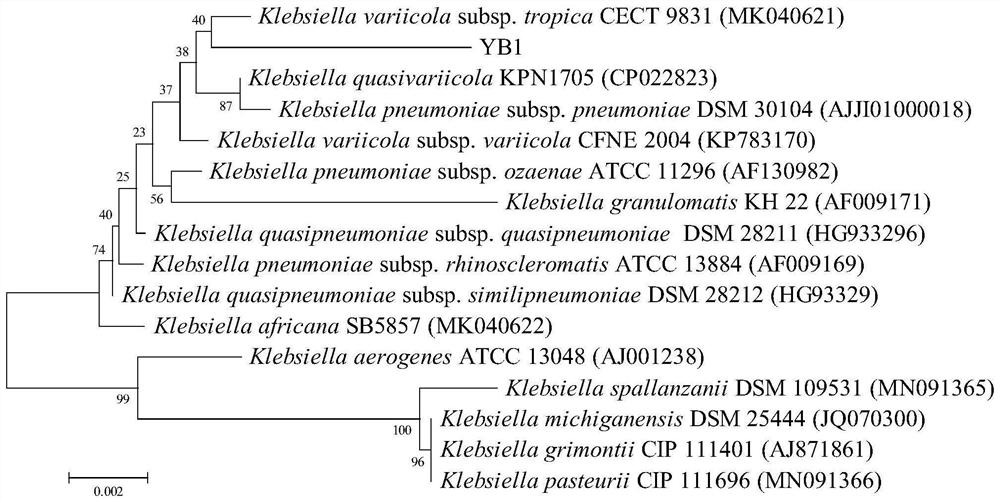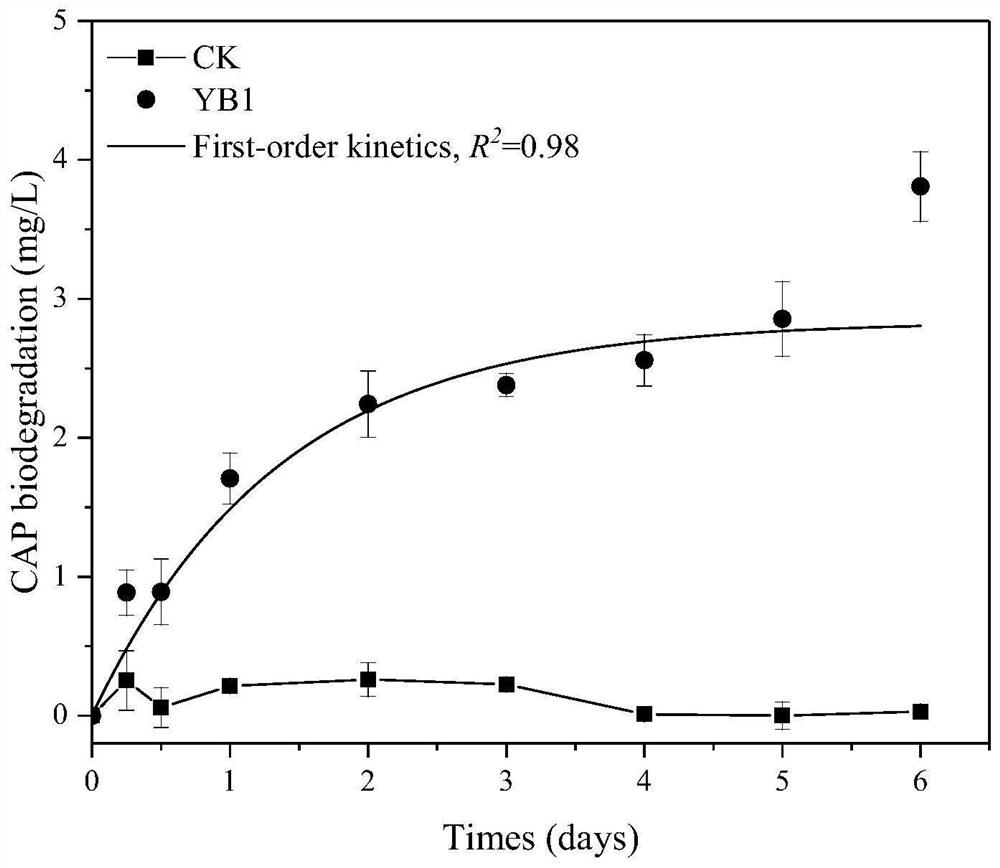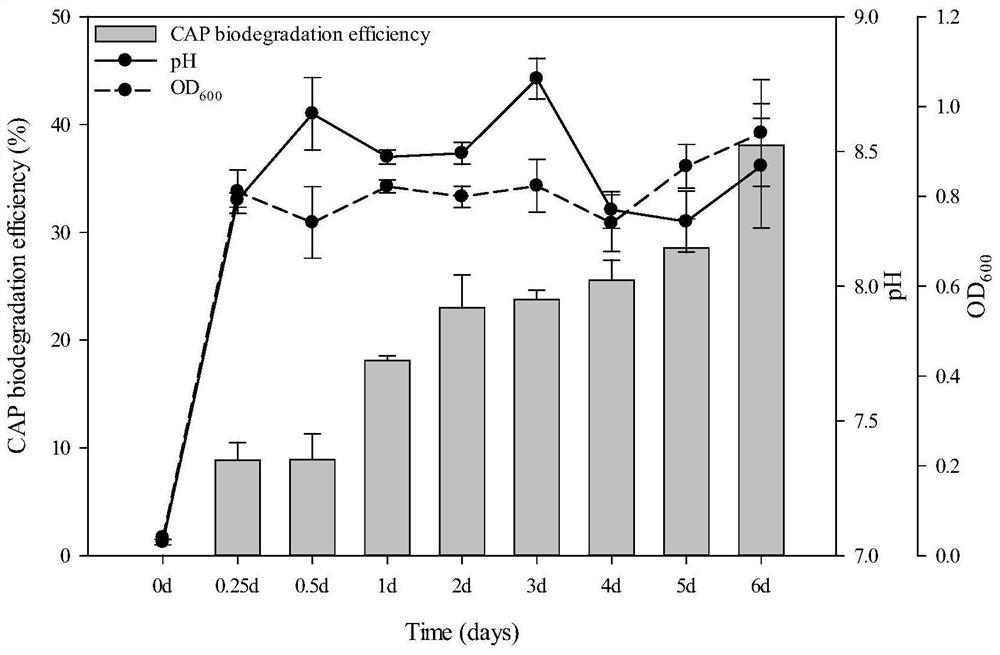Klebsiella variicola and application thereof in removal of chloramphenicol and cadmium ions
A technology of Klebsiella and Klebsiella, applied in the field of microbial remediation of organic pollutants, can solve problems such as secondary pollution, high energy consumption, and threats to ecosystems at trace levels, and achieve the goal of reducing chloramphenicol content Effect
- Summary
- Abstract
- Description
- Claims
- Application Information
AI Technical Summary
Problems solved by technology
Method used
Image
Examples
Embodiment 1
[0064] Screening, isolation and purification and identification of embodiment 1 bacterial strain YB1
[0065] 1. Screening method for chloramphenicol-degrading strain YB1
[0066] 1. Material preparation
[0067] Source of strain screening sample: An earthworm was excavated from a dry ditch next to a pig farm in Longping Town, Lianzhou City, Qingyuan, Guangdong Province. The earthworm and surrounding soil samples were sealed with sampling bags, brought back to the laboratory at 4°C, and immediately dissected to obtain intestinal tract contents.
[0068] LB medium: peptone 10.0g, yeast extract powder 5.0g, NaCl 10.0g, pH 7.0-7.2, distilled water to 1L, solid medium plus 18.0g agar powder. Sterilize at 121°C for 15 minutes.
[0069] Mineral salt medium (MSM): 5mL phosphate buffer solution (KH 2 PO 4 8.5g·L -1 、K 2 HPO 4 ·H 2 O2 1.75g·L -1 、Na 2 HPO 4 12H 2 O 33.4g·L -1 , NH 4 Cl 5.0g L -1 ), 3.0mL 22.5g·L -1 MgSO 4 Solution (MgSO 4 ·7H 2 O 46.125g·L -1 ), 1...
Embodiment 2
[0091] Example 2 Bacterial strain YB1 removes chloramphenicol test
[0092] Streak the strain YB1 on the LB plate and culture it at 30°C for 20h, pick a single colony and inoculate it in the LB liquid medium, culture it in the shaking table at 30°C and 150rpm for 20h, then inoculate it in the ratio of 2% (v / v) The concentration of chloramphenicol is 10mg·L -1 Contains 10g·L -1 In peptone MSM medium, 30°C, 150r min -1 Shaking culture was performed for 0, 0.25, 0.5, 1, 2, 3, 4, 5 and 6 days (d), with no addition of strain YB1 as the blank control (CK), and three repeated experiments were set up. Determination of strain YB1 to the removal amount and removal efficiency of chloramphenicol; Wherein the content of CAP is determined by HPLC (method is the same as in Example 1).
[0093] Strain YB1 contained 10g·L -1 Degradation kinetics of chloramphenicol in peptone MSM medium image 3 As shown, the degradation rate of chloramphenicol and the strain growth and pH changes as Fig...
Embodiment 3
[0094]The combined pollution test of cadmium ion and chloramphenicol of embodiment 3 bacterial strain YB1
[0095] Inoculate strain YB1 in LB liquid medium, at 125~150r·min -1 , 28~30℃ shaker shake culture for 18~24h, then inoculate Cd with 2% (v / v) inoculum 2+ (adding cadmium chloride) concentrations were 0, 2, 5, 10, 20, 50 mg / L and chloramphenicol concentration was 10 mg L -1 Contains 10g·L -1 In the MSM medium of peptone, set up 3 repeated experiments, place at 30°C, 150r min -1 Cultured in a shaker for 2 days. The removal amount and removal efficiency of cadmium ions and chloramphenicol were measured by bacterial strain YB1; wherein the content of CAP was measured by HPLC (the same method as in Example 1), and the content of cadmium ions was measured by AAS.
[0096] Strain YB1 contained cadmium ion concentrations of 0, 2, 5, 10, 20, 50 mg / L and chloramphenicol concentration of 10 mg·L -1 10g·L -1 The removal efficiency of cadmium ions in peptone MSM medium, as well...
PUM
| Property | Measurement | Unit |
|---|---|---|
| concentration | aaaaa | aaaaa |
Abstract
Description
Claims
Application Information
 Login to View More
Login to View More - R&D
- Intellectual Property
- Life Sciences
- Materials
- Tech Scout
- Unparalleled Data Quality
- Higher Quality Content
- 60% Fewer Hallucinations
Browse by: Latest US Patents, China's latest patents, Technical Efficacy Thesaurus, Application Domain, Technology Topic, Popular Technical Reports.
© 2025 PatSnap. All rights reserved.Legal|Privacy policy|Modern Slavery Act Transparency Statement|Sitemap|About US| Contact US: help@patsnap.com



